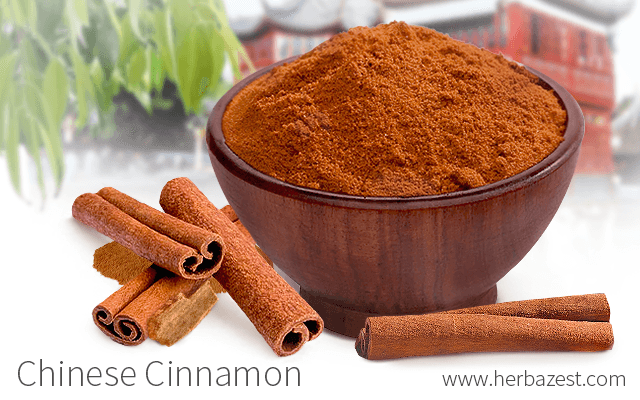The two most common types of cinnamon are Ceylon, or real cinnamon, and Chinese cinnamon. While these types share many similarities, they actually come from different plants and have slightly different make ups which influence their flavor, texture, appearance, health benefits, and side effects.
Cinnamon in Chinese
Since cinnamon has been around for so many centuries, it has adopted numerous names, which can add to the confusion of identifying specific varieties. The Chinese cinnamon tree goes by the botanical name of Cinnamomum cassia; however, the word for cinnamon in Chinese is either Kwei or Kui.
Chinese cinnamon is one of three cassia species, and it is often referred to simply as "cassia" in European and North American markets. The term is believed to derive from the Greek word kassia, which means "to strip off the bark."
While looking for these names can help identify Chinese cinnamon, cassia is often misnamed and mistaken as true cinnamon. Therefore, recognizing certain characteristics of Chinese cassia will help confirm that the correct species is selected.
Where Does Chinese Cinnamon Come from?
Chinese cassia is native to China, predominantly the Kwangsi and Kwangtung provinces. China is the main producer and exporter of Chinese cinnamon, alongside Bangladesh, India, and Vietnam. Chinese cinnamon is mainly cultivated for its bark, which is grown on small evergreen trees in tropical regions with a warm and humid environment.
The Chinese cinnamon bark is taken from wild and mature trees and used to make various cinnamon spice products, such as cinnamon sticks, ground cinnamon, cinnamon oil, and cinnamon supplements.
How to Identify Chinese Cinnamon
The majority of cinnamon spice sold in the United States and Canada is cassia - typically of the Chinese variety, which is less expensive than true cinnamon because it is more common. When buying cinnamon, price is a good indicator of the type; however, there are other characteristics to look for that will help confirm if the product is indeed Chinese cinnamon.
Chinese cinnamon has a much thicker and coarser texture than true cinnamon. This is because when Chinese cinnamon bark is harvested, it is taken in whole branches from small trees. The appearance of Chinese cinnamon quills is unique as well, and they are easily identified by their hollow tube.
A strong peppery flavor and reddish-dark brown color are also indicators of Chinese cinnamon.
Chinese Cinnamon Benefits
In China, the bark of Cinnamomum cassia is used to warm up and revitalize yang energy in spleen and kidneys, relieve pain, and improve blood circulation.
Chinese cinnamon bark is made up of 1-4% essential oil. The main active ingredient in the oils is cinnamaldehyde (70-95%), which has antiviral, antibacterial, antifungal, and anti-inflammatory properties that make it beneficial for treating numerous health conditions.1
Chinese cinnamon leaf oil has a strong aroma that is used for perfumes and flavoring in carbonated drinks. This oil provides all of the benefits of cinnamaldehyde as well as exhibits carminative activity, which means it is able to help treat flatulence.2
Additionally, cinnamaldehyde is believed to be responsible for cinnamon's ability to lower blood sugar and cholesterol as well as insulin resistance.3
Furthermore, thanks to its cinnamaldehyde content, the use of Chinese cinnamon for skin health is widely popular. Its essential oil is often used in personal care products - such as soaps, body oils, and moisturizers - due to its ability to deactivate and destroy bacteria and prevent microbial growth. However, it is recommended to dilute Chinese cinnamon oil before use since it is high in coumarin, which can trigger skin reactions when applied directly. It can also cause kidney and liver toxicity if ingested in large amounts.4
When it comes to medicinal uses, the benefits of cinnamon, regardless of its origin, are pretty much the same; however, Chinese cinnamon differs from real cinnamon when it comes to its unique oil composition and flavor.
Sources
- Cinnamon and Cassia: The Genus Cinnamomum, p. 1
- Handbook of Spices, Seasonings, and Flavorings, pp. 93-95
- Herbs & Spices of Thailand, pp. 36-38
- Juzen-taiho-to (Shi-Quan-Da-Bu-Tang): Scientific Evaluation and Clinical Applications, pp. 12-14
- Penn State University, Information: Cassia and Cinnamon
- The Cinnamon Book, pp. 36-40
Footnotes:
- International Journal of Green Pharmacy. (2012). A review on pharmacological activities of Cinnamomum cassia Blume. Retrieved November 19.2021, from: http://greenpharmacy.info/index.php/ijgp/article/view/245
- The American Journal of Chinese Medicine. (2006). Antimicrobial Activities of Cinnamon Oil and Cinnamaldehyde from the Chinese Medicinal Herb Cinnamomum cassia Blume. Retrieved November 19.2021, from: https://www.worldscientific.com/doi/abs/10.1142/s0192415x06004041
- Molecules. (2013). Identification of Compounds from the Water Soluble Extract of Cinnamomum cassia Barks and Their Inhibitory Effects against High-Glucose-Induced Mesangial Cells. Retrieved November 19.2021, from: https://www.mdpi.com/1420-3049/18/9/10930
- Regulatory Toxicology and Pharmacology. (2018). In vitro and in vivo safety studies of cinnamon extract (Cinnamomum cassia) on general and genetic toxicology. Retrieved November 19.2021, from: https://www.sciencedirect.com/science/article/abs/pii/S027323001830062X




